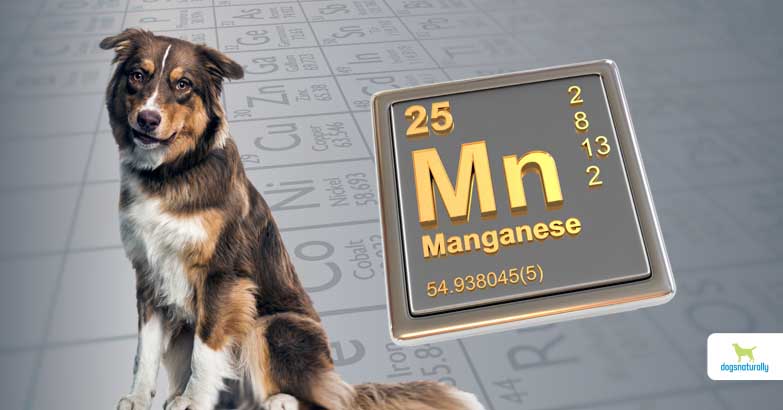Manganese is an essential mineral that your dog doesn’t need much of … but it’s vital to growth and joint health and dozens of other functions in his body. Getting enough manganese for dogs is simpler than it sounds.
Let’s take a look at manganese benefits for dogs …
Why Do Dogs Need Manganese?
Manganese is important to activate many enzymes required for normal metabolic function. Weak ligaments and tendons can be a sign of manganese deficiency. That’s because manganese activates the enzymes that are needed to build collagen, which gives strength to soft tissue. Collagen holds onto water and this hydrates collagen-rich connective tissue, making it more resilient. Without manganese, the body can’t make enough collagen and will do a poor job of repairing soft tissue damage and wound healing (1).
Manganese is an essential trace mineral with limited presence … but there is a long list of enzymes that require it for these important tasks (2).
- Bone, cartilage and collagen formation
- Energy production
- Fat metabolism
- Protein metabolism
- Carbohydrate metabolism
- Nerve function
- Brain function
- Reproductive function
- Immune system function
And manganese is important in the formation of the antioxidant enzyme superoxide dismutase that’s needed to protect against free radicals.
How Much Manganese Do Dogs Need?
Dogs can’t produce manganese so it must be obtained through their diet or a manganese supplement for dogs. According to the Association of American Feed Control Officials (AAFCO) the 2014 minimum standard is 1.25 mg/1000kcal daily for adult dogs (1.8 mg for puppies).
But the key question is, how did AAFCO come up with these numbers?
AAFCO’s Standards Of Manganese For Dogs
The National Research Council (NRC) requirements, on which AAFCO bases its requirements, looked at dog milk for its manganese values. It found that dog milk contains about 0.15 mcg/ml as fed.
Studies on other species show manganese in mother’s milk as 75-90% digestible. But, for commercial diets AAFCO bases its requirements on synthetic sources of manganese like manganese methionone or manganese carbonate, for which bioavailability is only 10%. So AAFCO likely padded the number to compensate for the lower bioavailability of these supplements.
Another factor in bioavailability of manganese in commercial foods is that processed dog foods are high in phytic or oxalic acid like soy, potatoes, legumes and grains … which can inhibit manganese absorption. Plus … dogs fed high starch diets will also have a more alkaline gut that doesn’t absorb minerals like manganese as well as the acidic gut of dogs on raw meat diets.
Manganese In Whole Foods
Manganese is in liver at about 1.5 to 2 ppm … and it’s also in bone at about the same levels. But AAFCO doesn’t provide the nutrients in bone so it’s ignored. Manganese is also found at about the same concentration in the pancreas and testes. So, adding liver, pancreas and testes as well as bone to food increases manganese, but likely still below AAFCO’s minimum requirements.
Manganese is also in a prey animal’s hair, feathers and wool at 10 to 20 ppm. So prey model feeders assume their dogs are getting enough manganese if they include these in the diet. But animal nutritionist Dr Richard S Patton PhD, says, sure … fur and feathers contain manganese … but “fur and feathers are notoriously poorly digested, usually appearing in the feces largely unchanged. It’s more prudent to look to other ingredients to fulfill manganese needs.”
So, is a dog really manganese deficient if he’s eating a whole food diet with a lower amount of manganese than AAFCO’s requirements, but with much higher bioavailability?
Even the NRC says, in Nutrient Requirements of Dogs And Cats, “Because of the paucity of information, it is difficult to provide absolute recommendations for dietary manganese.” Small Animal Clinical Nutrition (considered the gold standard for animal nutrition) says “Manganese deficiency is of little practical relevance in dogs and cats.” And a 1992 study by McDowell found that other minerals like magnesium can partially take over for manganese and drive its enzyme reactions – so it’s possible a deficiency might not have any real adverse effects on the dog.
It does appear that AAFCO requirements are exaggerated …. because it seems extremely unlikely that nature would create a manganese requirement in dogs that it can’t fulfill. Dr Patton agrees …
“It follows that anything eking a living from what grows on [the earth’s] crust will evolve to survive on the same occurrence rate of the nutrient. Creatures evolved to require in their diet pretty close to what their environment had to offer. All those who required more simply went extinct.”
Dr Patton describes this in detail in his book Ruined By Excess, Perfected By Lack.
How Do Dogs Get Sufficient Manganese?
Dr Patton is confident that dogs get sufficient manganese in their diets, both in commercial dog food and those feeding DIY diets.
“DIY advocates who include a variety of high quality natural ingredients are on the right path … and by including liver … which can be a good source of highly bioavailable manganese.”
Dr Patton points out: “Wolves and coyotes in the wild never consumed a single nanogram of store-bought vitamin or trace mineral, yet they managed to thrive for millions (billions?) of years.”
The animal protein with the highest level of manganese is raw beef liver which has about 0.40 mg per 100g. To get that amount from beef muscle meat you’d have to give your dog 10,000g – that’s 22 lbs.
Complicating things even more, iron, phosphorus and calcium can lower the absorption of manganese. Plus puppies and young dogs need larger amounts for growth. The breed of dog is also a consideration. Sledding breeds like the Malamute have trouble absorbing minerals, and need larger amounts to compensate.
Here are some manganese-rich foods you can add to your dog’s diet.
Sources Of Manganese For Dogs
Pet food formulator Steve Brown, author of Unlocking the Canine Ancestral Diet compiled a list of common food sources with adequate amounts of manganese. These are the amounts you need to feed to obtain 1g of manganese … so you can adjust as needed.
- Mussels: 29g
- Ginger: 3g
- Kelp: 18g
- Hemp seeds: 18g
- Pumpkin seeds: 21g
- Almonds: 46g
- Spirulina: 53g
- Pineapple: 108g
- Spinach: 111g
- Raspberries: 149g
- Kale: 152g
- Blackberries: 155g
- Oysters: 300g (10.5 oz)
- Beef liver: 323g (11 oz)
- Turkey liver, raw: 338g (12 oz)
- Sardines in water: 485g (17 oz)
- Beef heart: 2857g (6.3 lbs!!)
- Beef, ground, raw: 10,000g (22 lbs!!)
(28g = 1 oz)
You’ll also find small amounts of manganese in these dog-friendly foods:
- Green tripe: 1 oz contains .37 mg
- Seeds like chia, flax
- Green leafy vegetables
Dr Patton puts his faith in nature (aka evolution).
“Nature has perfected in all creatures an exquisite adaptability, the amazing capacity to find metabolic work-arounds for temporary lack of any nutrient and make up for it later when the nutrient is available.”
DNM RECOMMENDS: Four Leaf Rover offers Green Rover, a powdered blend of organic broccoli sprouts and fermented greens that provides manganese for dogs. Buy Green Rover now >>
Manganese Deficiency In Dogs
Experts agree that manganese deficiency isn’t common. But if it happens, it can cause weak joint formation and lead to joint issues that include hip dysplasia and cranial cruciate ligament (CCL) tears. Lack of manganese results in abnormal bone and cartilage development, disc degeneration (8) and reduced bone mineral density (3). Manganese is also needed for the synthesis of chondroitin sulfate, used in cartilage production.
Manganese is absorbed slowly so it can take weeks and usually months before a deficiency, or conversely, benefits are evident (4). By then, weakness or injury can be the first symptom. But if manganese is given as a supplement as this 2008 study (5) discovered, it can increase collagen development, bone mineral density and bone formation.
If you’re feeding a whole food raw diet that includes liver and/or some of the manganese-rich foods listed earlier, it’s unlikely your dog will be deficient.
But there’s a caution about kibble or other foods that might contain glyphosate …
Glyphosate In Dog Food
If you’re feeding kibble, despite manufacturers over-supplementing by as 300-400% above the required vitamins and minerals … you need to know about one other influence: glyphosate.
The herbicide glyphosate (Roundup) has been shown to reduce uptake of manganese. Researchers including MIT ‘s Stephanie Seneff found that glyphosate chelates (removes) manganese, and that cows fed genetically modified Roundup-Ready had severely depleted manganese levels affecting the liver, gut bacteria and neurological health (6).
Aside from the negative health effects, this also means that plant products used in dog food, particularly legumes and grains, may contain less manganese than presumed by nutrient analyses.
Glyphosate could also be a factor if you’re feeding non-organic or GMO produce or meat from factory farmed animals.
RELATED: Is Roundup safe for dogs?
Signs Of Manganese Deficiency
Manganese deficiency is usually most evident in newborn and young animals. Symptoms of manganese deficiency are:
- Poor growth and slow growth rate
- Skeletal abnormalities
- Reproductive failure
- Ataxia (loss of balance)
- Connective tissue and joint dysfunction
- Cruciate ligament weakness and tears
Signs you won’t readily see include:
- Abnormal blood clotting
- Reduced sex hormone production
- Reduced calcium absorption
- Poor blood sugar metabolism
Can Dogs Get Too Much Manganese?
It’s usually really hard for raw-fed dogs to get too much manganese from food sources. But manganese toxicity in dogs is a possibility if you feed too much manganese in supplement form. Too much synthetic manganese can be neurotoxic, as shown in this 2017 study (7).
Too much manganese can cause developmental problems and have a damaging effect on many organs, including the brain, liver, pancreas and reproductive system. Signs of manganese toxicity in domestic animals can include depressed growth, depressed appetite and diminished brain function.
Can you give a dog manganese?
What does manganese do for a dog?
So even though manganese is essential for so many things, it’s joint health where your dog will see the greatest benefit. And a tiny amount of manganese in your dog’s diet is all he needs to help maintain his mobility.
References
1. Linus Pauling Institute. Manganese. Oregon State University.
2. Manganese Fact Sheet. National Institutes of Health.
3. Tuormaa, Tuula. The Adverse Effects of Manganese Deficiency on Reproduction and Health: A Literature Review. Journal of Orthomolecular Medicine. Vol. 11, No. 2, 1996.
4 Aston, Barbara. Manganese and Man. Orthomolecular Medical Society Meeting. May 1980.
5. Bae, Yun-Jung, et al. Manganese supplementation improves mineral density of the spine and femur and serum osteocalcin in rats. Biol Trace Elem Res. 2008 Jul;124(1):28-34.
6. Samsel A, Seneff S. Glyphosate, pathways to modern diseases III: Manganese, neurological diseases, and associated pathologies. Surg Neurol Int. 2015 Mar 24;6:45.
7. Ferreira MDF, et al. Investigation of manganese homeostasis in dogs with anaemia and chronic enteropathy. Open Vet J. 2017;7(4):360-366.












